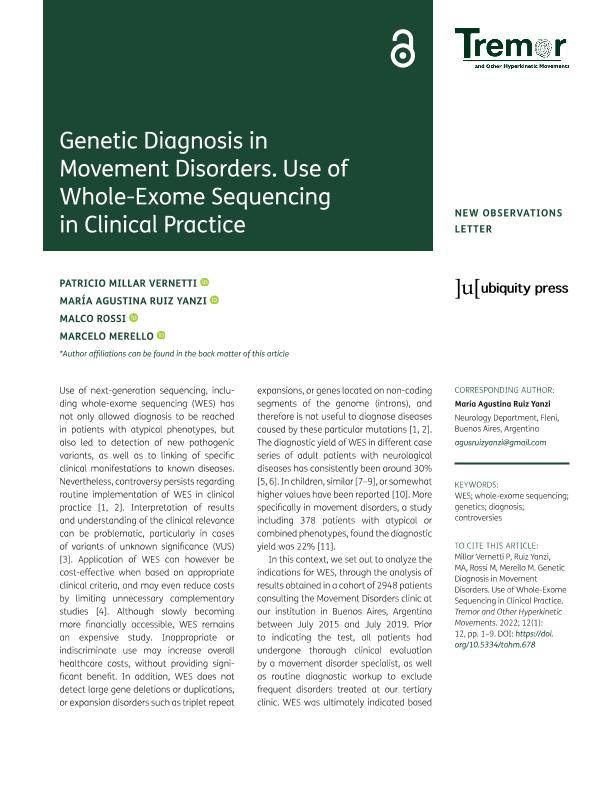Artículo
Genetic Diagnosis in Movement Disorders. Use of Whole-Exome Sequencing in Clinical Practice
Millar Vernetti, Patricio Alejandro; Ruiz Yanzi, María Agustina; Rossi, Malco Damian ; Merello, Marcelo Jorge
; Merello, Marcelo Jorge
 ; Merello, Marcelo Jorge
; Merello, Marcelo Jorge
Fecha de publicación:
04/2022
Editorial:
Ubiquity Press
Revista:
Tremor and Other Hyperkinetic Movements
e-ISSN:
2160-8288
Idioma:
Inglés
Tipo de recurso:
Artículo publicado
Clasificación temática:
Resumen
Use of next-generation sequencing, including whole-exome sequencing (WES) has not only allowed diagnosis to be reached in patients with atypical phenotypes, but also led to detection of new pathogenic variants, as well as to linking of specific clinical manifestations to known diseases. Nevertheless, controversy persists regarding routine implementation of WES in clinical practice [1, 2]. Interpretation of results and understanding of the clinical relevance can be problematic, particularly in cases of variants of unknown significance (VUS) [3]. Application of WES can however be cost-effective when based on appropriate clinical criteria, and may even reduce costs by limiting unnecessary complementary studies [4]. Although slowly becoming more financially accessible, WES remains an expensive study. Inappropriate or indiscriminate use may increase overall healthcare costs, without providing significant benefit. In addition, WES does not detect large gene deletions or duplications, or expansion disorders such as triplet repeat expansions, or genes located on non-coding segments of the genome (introns), and therefore is not useful to diagnose diseases caused by these particular mutations [1, 2]. The diagnostic yield of WES in different case series of adult patients with neurological diseases has consistently been around 30% [5, 6]. In children, similar [7–9], or somewhat higher values have been reported [10]. More specifically in movement disorders, a study including 378 patients with atypical or combined phenotypes, found the diagnostic yield was 22% [11].
Palabras clave:
CONTROVERSIES
,
DIAGNOSIS
,
GENETICS
,
WES
,
WHOLE-EXOME SEQUENCING
Archivos asociados
Licencia
Identificadores
Colecciones
Articulos (INEU)
Articulos de INSTITUTO DE NEUROCIENCIAS
Articulos de INSTITUTO DE NEUROCIENCIAS
Articulos(SEDE CENTRAL)
Articulos de SEDE CENTRAL
Articulos de SEDE CENTRAL
Citación
Millar Vernetti, Patricio Alejandro; Ruiz Yanzi, María Agustina; Rossi, Malco Damian; Merello, Marcelo Jorge; Genetic Diagnosis in Movement Disorders. Use of Whole-Exome Sequencing in Clinical Practice; Ubiquity Press; Tremor and Other Hyperkinetic Movements; 12; 1; 4-2022; 1-9
Compartir
Altmétricas



